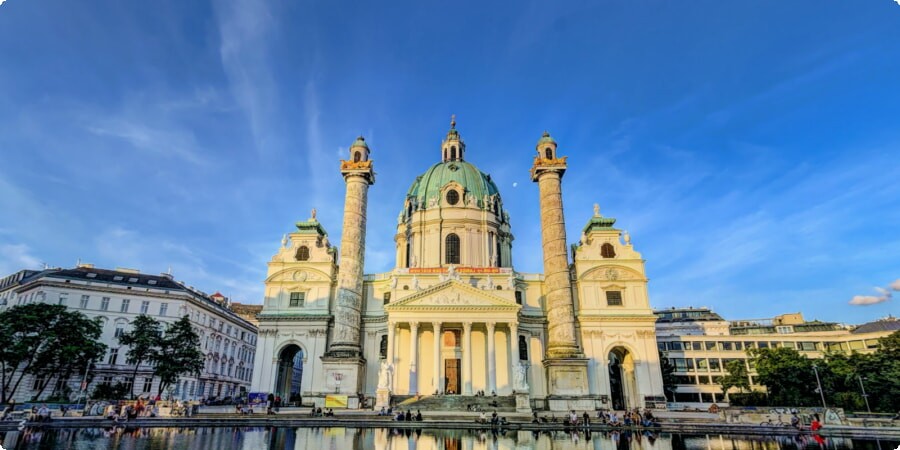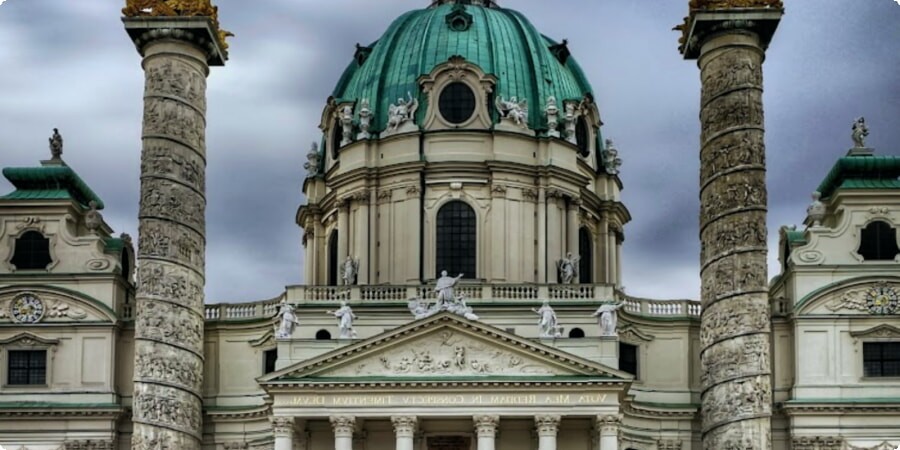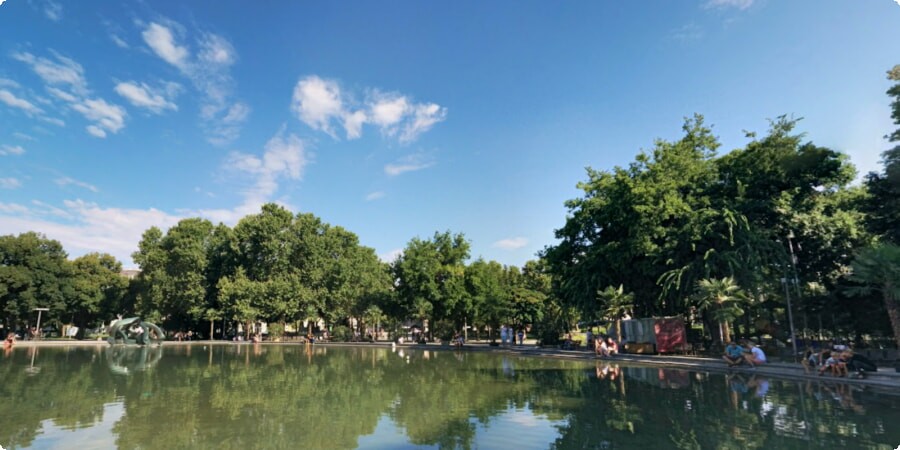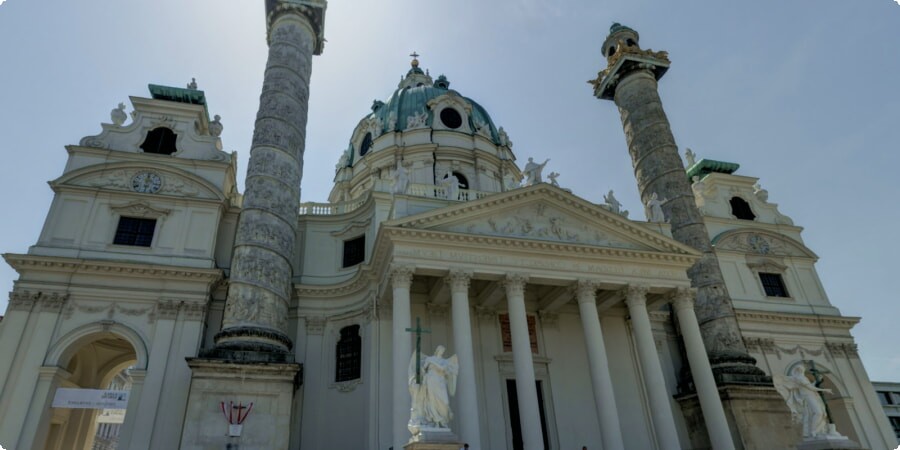Nestled in the heart of Vienna, Karlskirche, or St. Charles's Church, stands as a monumental example of Baroque architecture and a beacon of Vienna's rich cultural heritage. This iconic church, commissioned in the early 18th century, is a masterpiece that not only graces the city's skyline but also offers visitors a deep dive into Vienna's artistic and historical tapestry.
Karlskirche was built as a tribute to St. Charles Borromeo, a saint revered for his efforts during the plague that ravaged Vienna in the late 17th century. The church's design and grandeur are a testament to the artistic vision of its architects and the city’s resilience. As one of Vienna’s most striking landmarks, Karlskirche draws both history enthusiasts and casual visitors with its stunning architectural features and rich cultural significance.
Historical Origins: The Story Behind Karlskirche
The creation of Karlskirche was a direct response to the devastation of the plague that struck Vienna in 1713. Emperor Charles VI vowed to build a grand church dedicated to St. Charles Borromeo if the city was spared from further outbreaks. The emperor’s promise led to the inception of what would become one of Vienna’s most celebrated architectural marvels.
The design of Karlskirche was initially crafted by Johann Bernhard Fischer von Erlach, an acclaimed architect known for his Baroque style. Fischer von Erlach’s vision was a blend of classical elements with dramatic Baroque features, intended to convey both grandeur and divine beauty. After Fischer von Erlach’s death in 1723, his son, Joseph Emanuel Fischer von Erlach, took on the task of completing the project. He brought his own artistic flair to the church, ensuring that it would stand as a harmonious continuation of his father’s ambitious design.
The construction of Karlskirche spanned from 1716 to 1737, a period during which Vienna saw both political and social upheaval. Despite these challenges, the church emerged as a symbol of hope and renewal, reflecting the city's resilience and dedication to its cultural and religious values.
Architectural Marvels: Exploring the Exterior
Karlskirche is renowned for its striking Baroque architecture, which seamlessly combines classical elements with the opulence of the Baroque style. The church’s exterior is a visual spectacle, designed to impress and inspire awe.
The Dome: Dominating the skyline, the church’s dome reaches a height of over 70 meters. It is adorned with intricate frescoes by Johann Michael Rottmayr, depicting scenes from the life of St. Charles Borromeo. The dome’s elaborate design not only serves as a focal point of the church but also as a symbol of divine glory.
The Columns: Flanking the church’s entrance are two massive columns, each inspired by the Column of Trajan in Rome. These columns are not mere decorative elements but serve as narrative pillars, with reliefs depicting the life of St. Charles Borromeo. They symbolize strength and resilience, adding to the church’s monumental presence.

The Façade: The façade of Karlskirche blends classical temple forms with Baroque dynamism. The grand entrance is flanked by statues and allegorical figures that contribute to the church’s dramatic visual impact. The detailed carvings and sculptures enhance the church’s grandeur, making it a centerpiece of Vienna’s architectural landscape.
For visitors exploring Vienna, renting a car can provide the flexibility to fully enjoy the city's architectural treasures and historical sites. Consider booking a car through this recommended service for a convenient and comfortable travel experience.
Inside Karlskirche: Art and Interiors
The interior of Karlskirche is a breathtaking showcase of Baroque artistry, designed to captivate and inspire. As you step inside, the sheer scale and splendor of the space become immediately apparent.
Frescoes and Decorations: The church’s dome is adorned with a stunning fresco by Johann Michael Rottmayr, depicting the life and miracles of St. Charles Borromeo. The frescoes are renowned for their vibrant colors and dynamic composition, drawing the viewer's gaze upward to the heavens. The intricate stucco work, gilded details, and ornate carvings throughout the interior further enhance the church’s opulence.
The High Altar: The high altar, designed by Johann Bernhard Fischer von Erlach, is a focal point of the church. It features a grand altarpiece that represents St. Charles Borromeo ascending to heaven, surrounded by majestic columns and elaborate ornamentation. The altar’s design reflects the Baroque era's emphasis on dramatic effects and emotional impact.
The Organ: Another highlight of Karlskirche is its Baroque organ, a masterpiece of craftsmanship. Known for its rich and powerful sound, the organ is used in regular concerts that attract both locals and tourists. The intricate design of the organ case complements the church’s overall aesthetic, adding to the grandeur of the interior.
The Panoramic Elevator: A Unique Experience
One of Karlskirche's modern features is its panoramic elevator, offering visitors a unique vantage point of the church’s interior and the surrounding cityscape.
Elevator Ride: The elevator takes visitors up to a platform near the dome, allowing for an up-close view of the frescoes and architectural details that are otherwise difficult to appreciate. The ride itself is an experience, providing a glimpse into the intricate work that adorns the church’s dome.
Viewing Platform: Once at the top, the viewing platform offers a spectacular 360-degree view of Vienna. From here, you can see the city’s landmarks, including the Vienna State Opera and the historic center, set against the backdrop of the Vienna Woods. The panoramic views are particularly stunning during the early morning or late afternoon, when the city is bathed in golden light.
Photography Tips: For the best photographic opportunities, visit during the day when natural light illuminates the frescoes and provides clear views of the city. The platform is also a great spot to capture wide-angle shots of both the church’s interior and the surrounding urban landscape.
For those planning to explore beyond Vienna, renting a car can offer the freedom to visit other scenic locations in Austria. To book a reliable rental car, consider this car rental service.

Cultural and Religious Significance
Karlskirche is not just a beautiful architectural site but also a significant cultural and religious landmark in Vienna.
Religious Role: The church serves as an active place of worship and is integral to the local Catholic community. It hosts regular Masses and special services dedicated to St. Charles Borromeo, reflecting its ongoing role in Vienna's spiritual life.
Cultural Impact: Beyond its religious functions, Karlskirche plays a vital role in Vienna’s cultural scene. It hosts a range of events, from classical music concerts to special cultural programs, making it a lively center for the arts. The church’s acoustics and ambiance enhance these events, creating a unique environment for both performers and audiences.
Symbolic Legacy: The dedication of Karlskirche to St. Charles Borromeo, known for his work during the plague, symbolizes hope and resilience. The church stands as a testament to the enduring spirit of Vienna and its commitment to cultural and religious values. This legacy continues to resonate with visitors, making Karlskirche a profound and inspiring destination Karlskirche Significance.
Concerts and Events: The Cultural Hub of Karlskirche
Karlskirche is more than just a historical and architectural gem; it also serves as a vibrant cultural venue. The church regularly hosts concerts and events that enhance its role as a cultural hub in Vienna.
Musical Performances: One of the most popular attractions at Karlskirche is its classical music concerts. The church’s exceptional acoustics and grand interior provide a stunning backdrop for performances ranging from orchestral concerts to solo recitals. Renowned musicians and ensembles from around the world perform here, making it a must-visit for music enthusiasts.
Special Events: Beyond regular concerts, Karlskirche hosts a variety of special events throughout the year. These include seasonal festivals, art exhibitions, and community gatherings. The church’s majestic setting adds a unique charm to these events, drawing attendees who appreciate both the cultural programming and the historical ambiance of the space.
How to Attend: Tickets for concerts and events at Karlskirche can be purchased online or at the church’s ticket office. It’s advisable to book in advance, especially for popular performances. For up-to-date information on upcoming events and ticket availability, check the church’s official website or local event listings Karlskirche Events.

Visitor Information: Practical Tips and Recommendations
To make the most of your visit to Karlskirche, here are some practical tips and recommendations:
Opening Hours and Ticket Prices: Karlskirche is typically open to visitors daily. The church often has extended hours for special events and concerts. Admission fees for a general visit are modest, but prices for concerts and special tours may vary. Always check the latest details on the church’s official website or at the ticket counter upon arrival.
Accessibility: The church is wheelchair accessible, and there are facilities available for visitors with disabilities. The panoramic elevator provides an accessible way to view the church’s dome and surrounding cityscape.
Guided Tours: For a more in-depth experience, consider joining a guided tour. These tours offer insights into the church’s history, architecture, and artistic elements, led by knowledgeable guides. Tours are available in multiple languages, and booking in advance is recommended to secure a spot.
Nearby Attractions: Karlskirche is situated in a vibrant area of Vienna. Nearby attractions include the Belvedere Palace, the Vienna State Opera, and the Naschmarkt. Exploring these sites can enrich your visit to Vienna and provide a fuller experience of the city’s cultural and historical offerings.
For those planning to explore Vienna and its surroundings, renting a car can be convenient for travel. You can book a car through this recommended service for a hassle-free experience.

Exploring Vienna: What to See and Do Around Karlskirche
Karlskirche’s central location makes it an excellent starting point for discovering more of Vienna. Here are some suggestions for what to see and do in the vicinity:
Belvedere Palace: Just a short distance from Karlskirche, the Belvedere Palace complex offers a glimpse into Vienna’s imperial past. The palace houses an impressive collection of Austrian art, including Gustav Klimt’s famous "The Kiss." The gardens and the Upper Belvedere provide picturesque views and are perfect for a leisurely stroll.
Vienna State Opera: A visit to Vienna would be incomplete without experiencing its world-famous opera house. The Vienna State Opera, located not far from Karlskirche, hosts performances of classic operas and ballets. Guided tours are available for those interested in the building’s history and architecture.
Naschmarkt: For a taste of local life, head to the Naschmarkt, Vienna’s largest and most popular market. Here, you can sample fresh produce, gourmet foods, and international delicacies. The market’s lively atmosphere and diverse offerings make it a great spot for lunch or a snack.
Prater Park: If you’re looking to relax outdoors, Prater Park offers expansive green spaces and the iconic Giant Ferris Wheel. The park is ideal for a leisurely walk or a fun ride with panoramic views of Vienna.
Exploring these nearby attractions can complement your visit to Karlskirche and provide a richer experience of Vienna’s vibrant culture and history.
